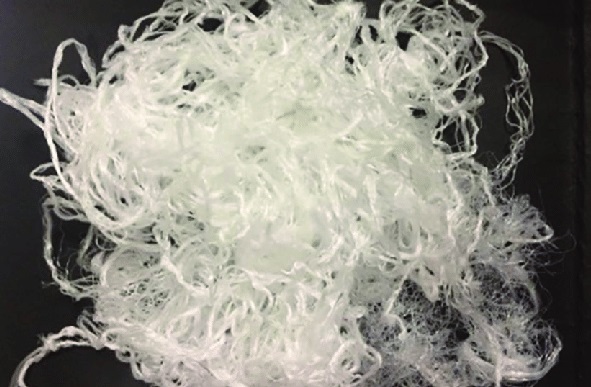What is Polyamide Fibre?
Polyamide fibre, also known as nylon fibre, is a synthetic fibre made from polymers containing amide monomers. It is a long-chain synthetic polyamide in which less than 85% of amide linkages are attached to two aromatic rings. Polyamide fibres are strong, durable, and lightweight, and they have a range of applications in the textile industry.
The first nylon produced by Du Pont was nylon 6.6, so called because its chemical components contain six carbon atoms per molecule. Nylon 6 was produced from a polyamide called caprolactam, which contain six carbon atoms. Some other forms of nylon were also developed, known as nylon 7, nylon 11, nylon 6.12 and nylon 4, 8, 10, and 6.10.

Nylon is produced in both regular and high-tenacity strengths. Although it is one of the lightest textile fibers, it is also one of the strongest. The strength of nylon will not deteriorate with age. It has the highest resistance to abrasion of any fiber.
It can take a tremendous amount of rubbing, scraping, bending, and twisting without breaking down. Nylon is one of the elastic fibers; however, such stretch nylon yarns as Helanca and Agilon have exceptional elasticity. It has excellent resilience and draping qualities. Nylon does not absorb much moisture; therefore the nylon fabric feels clammy and uncomfortable in warm, humid weather.
Polyamide is the second most important synthetic fibres material in terms of volume after polyester. A large number of different polyamides have been developed for technical use. Polyamides are available in many forms, including compliant textiles and rigid, resistant materials.
In polyamide fibres, at least 85% of the aliphatic chain components are linked by amide groups to form linear macromolecules. Characteristic of these are the recurring functional acid-amide groups [CO-NH] in the main chain.
Based on their chemical structure, polyamides can be divided into two groups:
- Aminocarboxylic acid types (AS) of one kind of monomer and
- Diamine dicarboxylic acid types (AA-SS) from two different monomers
Polyamide fibers can be produced in different forms, such as filaments, fibres, or yarns, depending on the desired end use. They are commonly used to make clothing, such as stockings, swimwear, and sportswear, as well as carpeting, upholstery, and other textiles. Polyamide fibres are also used in industrial applications, such as in tire cords, ropes, and conveyor belts.
Properties of Polyamide Fibre:
Polyamide fibres have several physical properties that make them suitable for a range of applications. Physical properties of polyamide fibre is given below table.
Physical properties of polyamide fibre:
| Property | Description |
| Density | 1.14 to 1.15 g/cm³ |
| Melting Point | 215-265°C |
| Tensile Strength | 4-9 g/den |
| Elastic Modulus | 0.5-3 GPa |
| Elongation at Break | 20-40% |
| Moisture Regain | 3-5% |
| Resistance to Abrasion | Good |
| Resistance to Chemicals | Good |
| Resistance to UV Light | Fair |
| Flammability | Self-extinguishing |
Other common properties of polyamide fibres are described below:
- Absorbency: Polyamide is not absorbent, and most of the moisture remains on the surface of the fabric. The material is generally smooth, so it dries quickly as the water either runs off easily or stays on the surface for the air to remove.
- Resilience: It possesses excellent elasticity and resilience. In spun and knitted polyamide products, however, resilience and elasticity are reduced.
- Strength: Polyamide is one of the strongest fibers (aramid and glass are stronger, though), and it does not deteriorate with age.
- Draping: It has excellent draping qualities regardless of the weight of the fabric.
- Insulating: Polyamide is warm and often used in outdoor apparel.
- Abrasion: Because it has high abrasion resistance, it can withstand excessive rubbing, wringing and scraping without breaking or any loss of strength.
- Lightweight: The degree of its lightness varies based upon the denier of the fiber but it is still considered to be lightweight.
- Resistance: Polyamide fibre is resistant to most chemicals, mildew, perspiration and insects.
- Susceptible: Polyamide will melt if an iron is too hot; therefore, the irons should be set on their lowest settings. Cold, concentrated solutions of mineral acids, such as hydrochloric, sulphuric and nitric acids, can decompose polyamide. The low absorption rate of polyamides can be problematic because it can make wearers feel clammy in warm, humid climates. Also of note: white nylon can yellow in sunlight.
Production of Polyamide Fibre (Nylon 6):
Production flow chart of polyamide fiber is given below.
Coal and petroleum bi-products are treated with hem methylene diamine and adipic acid.
↓
The mixture is heated to evaporate the water, which produces concentrated polyamide salt.
↓
This salt is treated with sulphuric acid, which creates cyclohexanone oxime (known as caprolactum).
↓
The caprolactum is heated in a steel drum to produce giant molecular chains called linear super polymers. These chains are mixed with titanium dioxide.
↓
The solution is filtered through slots, which remove all impurities. The solution ends up on revolving wheels. Where it is sprayed with cold water to solidify it into milky-white, opaque ribbons.
↓
The ribbons are chipped into flakes and placed into a hopper. There, they are melted.
↓
After that, hey are issued through a sand filter to remove any impurities.
↓
Melt Spun: After being filtered, they are extruded through the spinneret and solidified in cold air.
↓
A conditioner is added to moisten the fibers (making them stick together).
↓
A soft twist is added to the fibers before they are drawing to become two to seven times their original length. This process grants them greater strength and elasticity.
↓
Staple fibers are created ↔ Continuous Filament is created.
Uses / Applications of Polyamide Fibre:
Polyamide fibres are commonly used in various applications due to their unique properties such as high strength, durability, and resistance to wear and tear. Here are some of the most common applications of polyamide fibre:
a) Clothing:
Polyamide fibres are widely used in the clothing industry to produce fabrics, including sportswear, swimwear, lingerie, and hosiery. Nylon fabrics are lightweight, durable, and resistant to abrasion, making them ideal for sportswear and outdoor clothing. It is also used as parachute fabric.

b) Carpets and rugs:
Polyamide is often used in carpets and rugs because they are durable and resistant to abrasion and wear.
c) Industrial fabrics:
These fibres are used in a range of industrial fabrics, including tire cords, conveyor belts, and ropes, due to their strength, elasticity, and resistance to chemicals and heat.
d) Automotive industry:
Polyamide is used in automotive applications, such as airbags, seat belts, and car upholstery, due to their strength and resistance to abrasion and wear.
e) Home furnishings:
They are used in a range of home furnishings, such as curtains, upholstery, and bedding, due to their durability and resistance to wear and tear.
f) Fishing line:
Polyamide fibres are commonly used to make fishing lines due to their strength, elasticity, and resistance to water.
g) Medical textiles:
Polyamide are used in medical textiles, such as surgical sutures and implants, due to their biocompatibility and strength.
h) Electrical and electronic industry:
These fibres are used in electrical and electronic applications, such as cable insulation, due to their high dielectric strength and resistance to heat and chemicals.
i) Packaging:
Polyamide fibre is also used in the packaging industry to produce bags, films, and other products. Nylon packaging materials are durable and provide excellent moisture and gas barriers.
References:
- Fibres to Fabrics by Bev Ashford
- A Novel Green Treatment for Textiles: Plasma Treatment as a Sustainable Technology By Chi-wai Kan
- Textile Raw Materials By Ajay Jindal and Rakesh Jindal
- Textile Engineering – An Introduction Edited by Yasir Nawab
- Fibres: History, Production, Properties, Market by Dieter Veit
- Textile handbook by Hong Kong Cotton Spinners Association
You may also like:
